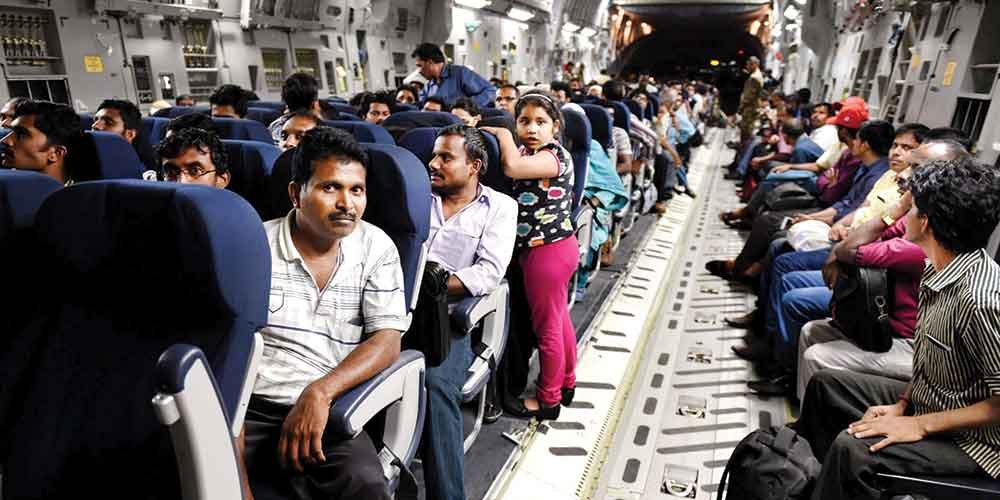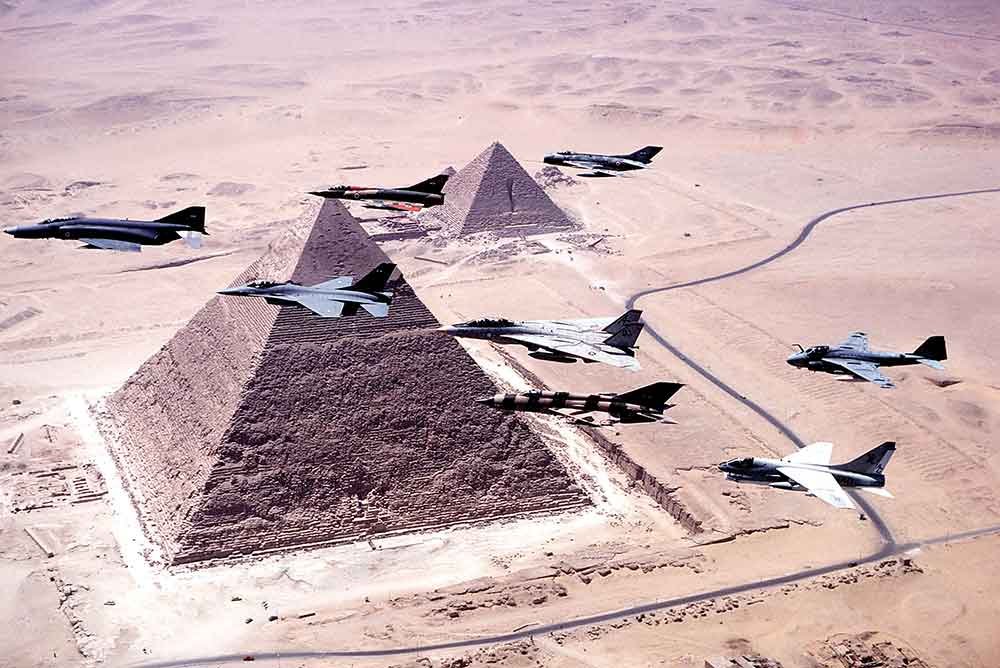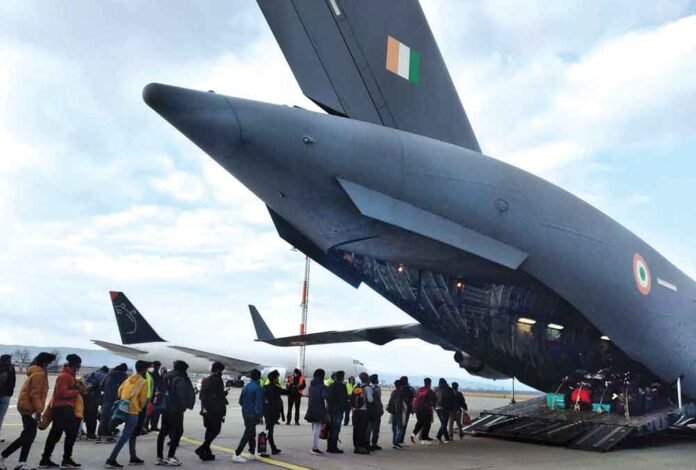Airpower diplomacy is increasingly emerging as a critical dimension of India’s strategic partnerships in the West Asia and North Africa (WANA) region. It embodies the strategic use of air force capabilities not only in combat, but also in humanitarian assistance, disaster relief, evacuation operations, joint exercises, and peacekeeping support, thereby advancing India’s foreign policy goals. The WANA region occupies a central place in India’s strategic calculus due to its geographic proximity, the presence of over 10 million Indian diaspora, the region’s role as India’s primary energy supplier, and its importance as a trade and connectivity hub. Against this backdrop, the Indian Air Force (IAF) has become a key instrument of India’s defence diplomacy, ensuring India’s interests are safeguarded while simultaneously positioning India as a reliable and responsive partner in regional security frameworks.
India’s concern for its diaspora has historically shaped its use of airpower diplomacy in the region. The 1990 Gulf War was a defining episode, where the evacuation of nearly 170,000 Indians from Kuwait became one of the largest air evacuations in history, conducted primarily through Air India’s civil fleet. While this was not an IAF-led operation, it underscored the necessity of aerial evacuation capabilities to protect nationals in crises. Since then, the IAF has repeatedly demonstrated its effectiveness in such missions. Whether during the 2011 Arab Uprisings, the 2015 Yemen crisis (Operation Raahat), or more recently in evacuations from Sudan (Operation Kaveri) and Israel (Operation Ajay), India has relied heavily on airpower to ensure the safety of its citizens. Unlike naval or land operations, aerial evacuation is faster, requires fewer logistical arrangements, and can operate even when borders or seas are contested, making it an indispensable tool of diplomacy in volatile regions like WANA.
This experience has shaped India’s evolving evacuation policy, in which airpower now occupies a central role. Earlier evacuations, such as the Kuwait airlift, relied predominantly on civilian carriers like Air India. However, the complexities of modern crises, from armed conflict to hybrid warfare, have necessitated a more robust, military-led evacuation approach. The Ministry of External Affairs (MEA) and the Ministry of Defence (MoD) now work in tandem to integrate IAF assets directly into contingency planning. Strategic airlift platforms such as the C-17 Globemaster III and C-130J Super Hercules are now designated as primary tools for rapid evacuation. These aircraft not only ensure speed and scale in moving large numbers of citizens, but also provide greater flexibility in landing at semi-prepared runways in conflict zones. The policy shift is evident in recent operations, where the IAF has conducted parallel evacuations alongside civil aviation, highlighting that evacuation is no longer treated as a purely logistical exercise but as a national security imperative where airpower is decisive.
Airpower diplomacy has also been vital in humanitarian assistance and disaster relief (HADR). The IAF’s strategic lift capabilities, such as C-17 Globemaster, C-130J Super Hercules, and IL-76 aircraft, have enabled India to provide timely aid to partner countries in distress. During the COVID-19 pandemic, the IAF played a frontline role in the Vaccine Maitri initiative, flying medical supplies, vaccines, and oxygen concentrators to partners in West Asia. When Turkiye was struck by a devastating earthquake in 2023, the IAF launched Operation Dost, airlifting relief materials, specialised equipment, and rescue teams within hours of the tragedy. Similarly, after the Beirut port explosion in 2020, the IAF was used to deliver aid rapidly, reinforcing India’s credibility as a reliable first responder. In earlier years, during the Yemen crisis, the IAF evacuated not only Indians but also nationals from more than 40 countries, showcasing India’s role as a global humanitarian actor. India has also supplied relief materials by air to war-affected civilians in Syria and extended medical aid to Gaza, underscoring its commitment to balancing diplomacy with compassion. These HADR efforts, rooted in the ethos of Vasudhaiva Kutumbakam (the world is one family), go beyond goodwill; they have deepened trust, strengthened bilateral ties and positioned India as a responsible stakeholder in regional security.
Airspace access in friendly countries facilitates India’s rapid response capability, whether for evacuation, HADR, or strategic deployments. Given the region’s centrality to global trade routes and energy flows, ensuring that India maintains overflight permissions and operational familiarity is a strategic necessity
Alongside humanitarian roles, joint aerial exercises between India and WANA states have become a prominent feature of defence cooperation. The IAF has actively participated in exercises such as Bright Star in Egypt and Desert Flag in the UAE, where it has flown advanced platforms like the MiG-29, Jaguar, and Su-30 MKI. These exercises allow Indian pilots to operate in diverse desert environments, refine interoperability with air forces of the United States, France, and Saudi Arabia, and build trust with host nations. The IAF’s recent participation in Desert Flag-10, from April 21 to May 8, 2025, alongside contingents from Australia, Bahrain, France, Germany, Qatar, Saudi Arabia, South Korea, Turkey, the UAE, the UK, and the US, underscores the importance India attaches to multilateral air cooperation in the Gulf. Similarly, India’s participation with Egyptian forces in the large-scale multilateral Exercise Bright Star 2025 from August 28 to September 10, involving 700 personnel from the Indian Army, Navy and Air Force, aimed to enhance strategic ties, foster interoperability and provide a mutual learning exercise. These engagements are not symbolic; they enhance India’s strategic visibility, operational learning, and ability to integrate with international forces during contingencies.
India’s bilateral air engagements with Saudi Arabia, Oman, Israel, and Egypt reflect the maturing of defence ties. With Saudi Arabia, the IAF has conducted exercises that reinforce mutual trust in the security domain. Oman, with which India shares deep maritime and defence linkages, has hosted regular IAF deployments, reflecting Muscat’s role as a gateway for India into the Gulf. Likewise, with Israel, cooperation has included advanced training modules and the acquisition of cutting-edge technologies such as UAVs and air defence systems, strengthening the IAF’s operational edge. Egypt’s Bright Star exercises, historically among the largest in the region, have given India a platform to demonstrate its long-range deployment capabilities. These joint engagements highlight that airpower diplomacy was among the first avenues through which India built meaningful defence cooperation with the region, even before more complex naval and land-based exercises gained prominence.

The importance of air diplomacy in the WANA region is further amplified by its geography and geopolitics. Airspace access in friendly countries facilitates India’s rapid response capability, whether for evacuation, HADR, or strategic deployments. Given the region’s centrality to global trade routes and energy flows, ensuring that India maintains overflight permissions and operational familiarity is a strategic necessity. Moreover, as regional conflicts, ranging from the Syrian crisis to the Gaza war, continue to shape security dynamics, the IAF’s demonstrated ability to operate in hostile or semi-permissive environments makes it a valuable partner for regional air forces seeking both operational training and strategic reassurance.
Historical precedent also underscores the combat role of airpower diplomacy. India’s use of the IAF in the 1971 war to support Mukti Bahini in the then East Pakistan, now Bangladesh, showed the utility of airpower in supporting liberation struggles and building diplomatic goodwill. In the WANA context, India has refrained from combat interventions but has consistently projected airpower as a stabilising and supportive instrument. The deployment of IAF contingents for United Nations peacekeeping missions has further reinforced India’s image as a responsible global actor, committed to collective security rather than unilateral adventurism.
Airpower diplomacy also intersects with India’s broader maritime vision of Security and Growth for All in the Region (SAGAR) and MAHASAGAR. While both SAGAR and MAHASAGAR have primarily been associated with the Indian Ocean, the IAF’s ability to complement naval operations through reconnaissance, strategic lift, and rapid deployment has extended India’s influence into the Red Sea, Gulf of Aden, and beyond. For instance, the IAF’s ability to rapidly deploy troops and equipment has been crucial in supporting Indian naval operations for anti-piracy and maritime security in the Arabian Sea and the Gulf of Oman. This synergy of air and naval diplomacy enhances India’s image as a regional security provider.
The emergence of drone warfare, cyber threats targeting aviation networks, and the militarisation of airspace through advanced missile systems demand continuous modernisation of the IAF. Collaborative exercises should increasingly focus on counter-drone operations, integrated air defence, and joint responses to hybrid threats
Looking ahead, India’s airpower diplomacy in the WANA region must adapt to evolving security challenges. The emergence of drone warfare, cyber threats targeting aviation networks, and the militarisation of airspace through advanced missile systems demand continuous modernisation of the IAF. Collaborative exercises should increasingly focus on counter-drone operations, integrated air defence, and joint responses to hybrid threats. Expanding trilateral and minilateral air cooperation, for instance, involving India, the UAE, and France, could further embed India into the evolving security architecture of the region. Moreover, India must leverage its growing defence industrial base to offer training, maintenance, and joint production in aerospace technologies, thereby reinforcing airpower diplomacy with tangible economic partnerships.

Ultimately, India’s airpower diplomacy in West Asia and North Africa represents a synthesis of hard and soft power. It is rooted in the need to protect nationals, but extends to humanitarian commitments, joint exercises, and regional security provision. The agility, speed, and reach of the IAF make it uniquely suited to address the region’s volatility, while showcasing India’s strategic intent to be a credible partner and stabilising force. By combining operational competence with diplomatic foresight, and by embedding airpower into its evacuation policy as a permanent and indispensable feature, India is carving out a role for itself where airpower is not merely an element of defence, but a critical lever of foreign policy. In an era where the WANA region continues to shape global energy, trade, and security flows, India’s ability to project and utilise airpower diplomacy will remain central to safeguarding its interests and deepening its partnerships.
The writer focuses on contemporary Middle Eastern affairs and is the author of 'India and the Gulf: A Security Perspective'. She is also a subject matter expert at the Centre for Joint Warfare Studies.






